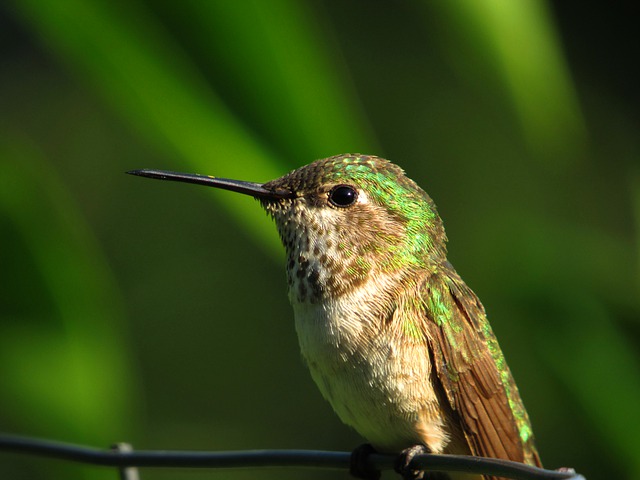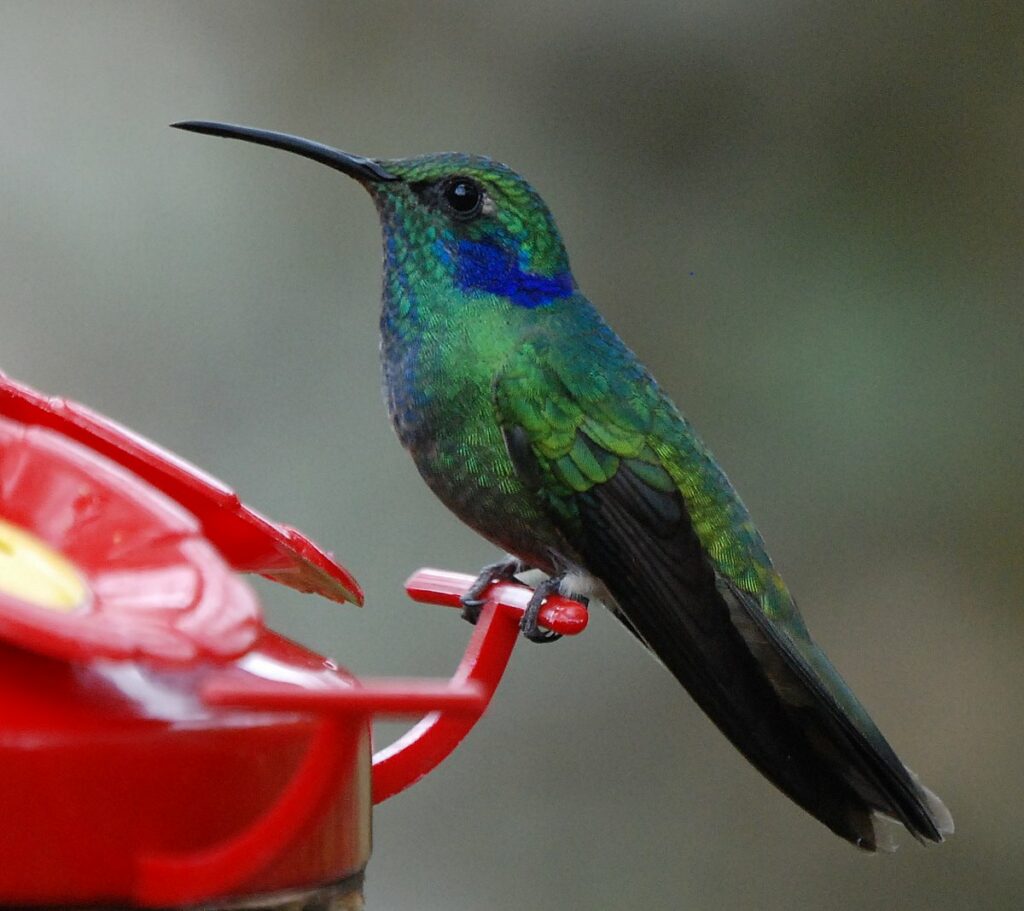Maine is home to a variety of different species of birds, including several types of hummingbirds.
These tiny, colorful birds are a favorite among birdwatchers and can often be seen flitting around gardens and backyard feeders.
In this article, I will introduce you to four of the most common types of hummingbirds found in Maine: the Ruby-Throated Hummingbird, the Calliope Hummingbird, the Mexican Violetear, and the Rufous Hummingbird.
Read on to learn more about these fascinating birds and where you can find them in Maine.
| Image | Name |
|---|---|
 | Ruby-Throated Hummingbird |
 | Calliope Hummingbird |
 | Mexican Violetear |
 | Rufous Hummingbird |
Types of Hummingbirds in Maine
1. Ruby-Throated Hummingbird

The Ruby-throated Hummingbirds male usually has a dark, almost blackish face along with an iridescent red gorget that has the potential to look dark under certain lighting conditions.
Moreover, males have a gray-white breast that is shaped like a vest, darker wings, bright green metallic crowns and flanks, and forked-like tails with a bluish-violet sheen.
These characteristics can be distinguished by looking at the animal from different angles.
Ruby-throated Hummingbirds Females can have white throats that are unmarked or have very light markings, and they have dark streaks and a slight buff sheen on their flanks.
In addition to this, the sides of females are a grayish-green color and are not as brilliant as the sides of males.
Furthermore, females possess a notched tail, whereas males possess a deeply forked tail.
The breeding grounds for ruby-throated hummingbirds are typically found across the eastern part of the United States.
During the migration season, these birds move southward to South and Central America to spend the winter.
In spite of this, they are considered native breeders of Maine, coming into the state in the early spring and staying until the freezing temperatures set in.
The Ruby-throated Hummingbird is the species of hummingbird that is seen in the highest numbers in Maine during the summer months.
It is included in 12% of the checklists that bird watchers submit for the state.
As is the case with many other species of hummingbirds, Ruby-throated hummingbirds get the majority of their nutrition from either insects or the nectar-filled flowers of trees, shrubs, and epiphytes.
This allows them to maintain their high activity levels.
Therefore, you might want to think about planting bright, appealing flower spots with a higher proportion of sugar in your backyard in order to entice these flightless birds.
When they are near sources of food, both female and male Ruby-throats have the potential to be aggressive birds.
In these situations, they will typically use dive displays or distinctive aerial to protect their area and ward off unwanted visitors.
It is pretty incredible that during the fall and spring migrations, Ruby-throated Hummingbirds are able to complete a single flight that is nonstop and covers a distance of 500 miles, considering that their body weight can be as small as one penny in the United States.
The thistle or dandelion down that is used in the construction of ruby-throated female nests is held together along with spider silk.
The nests are built by ruby-throated females on light branches.
They hatch about one to three very small eggs, each measuring hardly 0.6 in (1.3 cm)
2. Calliope Hummingbird

Hummingbirds having calliope plumage have top feathers that are shiny green and feathers that are creamy white.
Their beaks and tails are also rather small.
Male Calliopes have a white throat with distinctive, iridescent, elongated wine-red throat feathers that, when erected, have the appearance of being “whiskered.”
In contrast, the female Calliope hummingbirds have a dull white gorget with fine dots or streaks, a pinkish wash on their flanks, and black tails with white ends.
They also have somewhat longer tails than males.
In the state of Maine, the Calliope Hummingbird is considered an accidental species.
They are incredibly hard to come by in this area, and the last time anybody saw one was in Blue Hill in 2008.
Hummingbirds of the species Calliope are the tiniest breeders found in North America.
They are found across Canada and the United States.
The only species of smaller bird ever discovered in the United States was another type of hummingbird called the bumblebee hummingbird.
This bird is native to Mexico, but it was noticed in the United States by accident.
The Calliope Hummingbird is a migratory bird that usually nests in open shrubs and at high altitudes in rocky mountains.
In addition to this, they leave their breeding ground earlier than the majority of other bird species do in order to take advantage of the late-summer wildflowers in the mountain ranges of western North America prior to departing for their winter residence.
This is the case because they leave their breeding ground sooner than most of the other bird species.
Hummingbirds of the genus Calliope are distinguished by their status as the world’s tiniest long-distance travelers.
Nests are often built on evergreen trees, and birds may reuse existing nests or construct new ones on top of older ones.
3. Mexican Violetear

The plumage of Mexican violetears ranges from emerald to metallic green overall, and they have greenish-blue tails featuring bronzy center feathers.
Their cheeks and breasts are a dark, iridescent violet color.
Accidental species of the Mexican Violetear have been found in Maine.
They were only seen once in Hancock in 2007, according to the archives, making their appearance here an exceptionally unusual occurrence.
The Mexican violetear hummingbird is a medium size bird that may be found in the forests of Nicaragua, Mexico, and the southwestern United States.
Its range extends all the way to Nicaragua. It is, however, a relatively itinerant bird, which means that even though it is an uncommon sight in Maine, there are a few of these wanderers that may make it there.
Male Mexican violetears are very loud birds who prefer to sing a chipping, jerky, metallic tune from small branches in their territorial zones.
This song may be heard across their territories.
These migratory hummingbirds often prefer to forage alone while eating at mid-level to canopy zones in regions that have been cleared of their natural forest habitat.
On occasion, though, these hostile and territorial birds may congregate near blooming trees, particularly the coffee-shade Inga.
Hummingbirds found in Mexico are classified under the Apodiformes order, which literally translates to “without foot.”
Hummingbirds with Mexican violetears do in fact, have feet, but they are very small and fragile, thus the birds hardly ever walk.
4. Rufous Hummingbird

Male Rufous Hummingbirds possess a rusty, copper-orange, and rufous coloring on their flanks, crown, and back, and they have an iridescent orange-red throat.
In addition, between five and ten percent of males have a bluish-green wash on their backs and heads.
The gorgets of female Rufous hummingbirds are white and a little speckled, and they have an orange-red splotch in the center.
Their backs and heads are green. Last but not least, the females have chests and sides buff in color, and their tails are dark green with a rusty and rufous base.
Although they are considered to be of near-threatened status, Rufous Hummingbirds have been observed in Maine between the months of October and December.
They are extremely uncommon in this area, but in the year 2020, one was seen in Yarmouth.
The behavior of rufous hummingbirds in feeding regions, including areas close to backyard bird feeders, is notorious for being extremely aggressive.
This behavior extends even to larger birds.
They typically engage in a number of different types of threatening behaviors, such as tail fanning, diving displays, and high-pitched noises that chatter.
If you want to entice Rufous hummingbirds towards your backyard, you should make sure to set up multiple bird feeding sites in your garden that are spread out over a wide area in order to entice these tiny birds; the more space there is between them, the better!
Because of the way in which they consume their food, if you place one hummingbird feeder in a different location than another, you will give other hummingbirds that have wandered off the chance to consume the sugar water.
Rufous hummingbirds, despite their small bodies, have the longest migration patterns of any bird in the United States.
They travel an astounding 2,000 miles from Mexico to Alaska and back again each way.
The nectar of brightly colored tubular flowers is the primary source of nutrition for Rufous Hummingbirds.
They also eat small insects like gnats, midges, and flies.
They construct the nest in the branches of trees, using the fluffy down from plants as insulation and the webs of spiders as the binding material.
They lay two to three very small, white eggs that are about half an inch (1.3 centimeters) long. Mountain meadows and coniferous forests make up their natural environment.
Conclusion
To this day, it has been documented that four distinct species of hummingbirds have been seen in the state of Maine.
These include the Ruby-throated, Calliope hummingbirds, Rufous, and Mexican violetear.
The three species are very infrequent visitors, with the exception of the Ruby-throated Hummingbird.
On the other hand, if you are fortunate enough to see one of these gorgeous birds flying around the forest or your garden, it will be a sight that will take your breath away.
FAQ
How many different kinds of hummingbirds may be found in the state of Maine?
Even though there are only one species of hummingbird within Maine, there are more than a hundred more known species across the American West and Southwest, and many more may be found in Mexico. These species will often move to the east rather than the south, and they will appear in the autumn and winter months in search of food.
When is it OK to cease giving hummingbird feeders in Maine?
Late in the month of October, or around two weeks after you do not see any hummingbirds feeding at your feeders, you may tear down your hummingbird feeders within Maine. Towards the end of September, hummingbirds will begin their migration out from Maine.
Do hummingbirds take a break from feeding throughout the night?
Hummingbirds, as a rule, do not consume food at night while they are active. They like to rest in order to save their energy and function normally. The presence of strong artificial lights, on the other hand, increases the likelihood that you may observe a hummer flying over your yard in the evening. This is due to the fact that the bird is capturing insects that are maybe drawn to the light.
Last Updated on March 22, 2023 by Lily Aldrin
